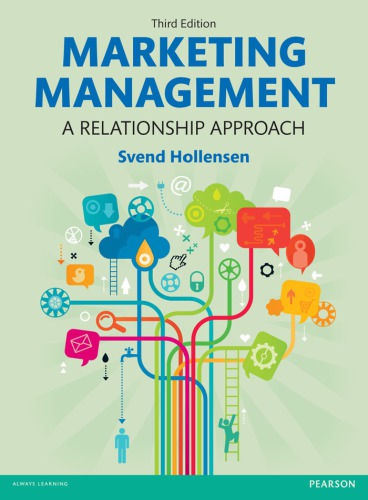

Most ebook files are in PDF format, so you can easily read them using various software such as Foxit Reader or directly on the Google Chrome browser.
Some ebook files are released by publishers in other formats such as .awz, .mobi, .epub, .fb2, etc. You may need to install specific software to read these formats on mobile/PC, such as Calibre.
Please read the tutorial at this link: https://ebookbell.com/faq
We offer FREE conversion to the popular formats you request; however, this may take some time. Therefore, right after payment, please email us, and we will try to provide the service as quickly as possible.
For some exceptional file formats or broken links (if any), please refrain from opening any disputes. Instead, email us first, and we will try to assist within a maximum of 6 hours.
EbookBell Team

0.0
0 reviews
ISBN 10: 0273778854
ISBN 13: 9780273778851
Author: Svend Hollensen
Chapter 1: Introduction
1.1 Introduction
1.2 The Marketing Management Process
1.3 The Traditional (Transactional) Marketing Concept vs. the Relationship Marketing Concept
1.4 Balancing the Transactional and Relationship Concepts Throughout the Book
1.5 How the RM (Relationship Marketing) Concept Influences the Traditional Marketing Concept
1.6 Different Organisational Forms of RM
1.7 Summary
Case Study 1.1 Hunter Boot Ltd: the iconic British brand is moving into exclusive fashions
Questions for Discussion
References
PART I: Assessing the Competitiveness of the Firm (Internal)
Chapter 2: Identification of the Firm’s Core Competences
Learning Objectives
2.1 Introduction
2.2 Roots of Competitive Advantage
2.3 The Resource-Based View (RBV)
2.4 Market Orientation View (MOV) compared to the Resource-Based View
2.5 The Value Chain-Based View (VBV)
2.6 The Value Shop and the “Service Value Chain”
2.7 Internationalising the Value Chain
2.8 The Virtual Value Chain
2.9 Experimental Marketing
2.10 Summary
Case Study 2.1 Zalando: how can the online apparel retailer turn financial losses into positive profits?
Questions for Discussion
References
Chapter 3: Development of the Firm’s Competitive Advantage
Learning Objectives
3.1 Introduction
3.2 General Sources of Competitive Advantage
3.3 Introduction of a Holistic Model of Competitiveness: from Macro to Micro Level
3.4 Analysis of National Competitiveness (the Porter Diamond)
3.5 Competitive Analysis in an Industry
3.6 Value Chain Analysis
3.7 Blue Ocean Strategy and Value Innovation
3.8 Outsourcing – a Strategic Decision Framework based on Customers’ Evaluation
3.9 Summary
Case Study 3.1 Nintendo Wii: Nintendo’s Wii took first place on the world market – but it didn’t last
Questions for Discussion
References
PART II: Assessing the External Marketing Situation
Chapter 4: Customer Behaviour
Learning Objectives
4.1 Introduction
4.2 Consumer B2C Decision Making
4.3 Influences on Consumers’ Decision Making
4.4 Organisational B2B Decision Making
4.5 Influences on the Buying Process
4.6 Customer-Perceived Value and Relationship Marketing
Summary & Case Study & Questions
References
Chapter 5: Competitor Analysis and Intelligence
Chapter 6: Analysing Relationships in the Value Chain
hollensen s 2019 marketing management a relationship approach
hollensen s 2019 marketing management a relationship approach pearson
hollensen s 2015 marketing management a relationship approach pearson
hollensen marketing management a relationship approach
marketing management a relationship approach pdf
Tags: Svend Hollensen, management, relationship